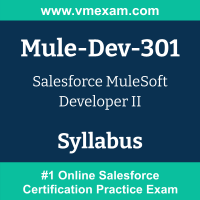 The Salesforce Mule-Dev-301 exam preparation guide is designed to provide candidates with necessary information about the MuleSoft Developer II exam. It includes exam summary, sample questions, practice test, objectives and ways to interpret the exam objectives to enable candidates to assess the types of questions-answers that may be asked during the Salesforce Certified MuleSoft Developer II exam.
The Salesforce Mule-Dev-301 exam preparation guide is designed to provide candidates with necessary information about the MuleSoft Developer II exam. It includes exam summary, sample questions, practice test, objectives and ways to interpret the exam objectives to enable candidates to assess the types of questions-answers that may be asked during the Salesforce Certified MuleSoft Developer II exam.
It is recommended for all the candidates to refer the Mule-Dev-301 objectives and sample questions provided in this preparation guide. The Salesforce MuleSoft Developer II certification is mainly targeted to the candidates who want to build their career in Salesforce Developer domain and demonstrate their expertise. We suggest you to use practice exam listed in this cert guide to get used to with exam environment and identify the knowledge areas where you need more work prior to taking the actual Salesforce MuleSoft Developer II exam.
Salesforce Mule-Dev-301 Exam Summary:
| Exam Name | Salesforce MuleSoft Developer II |
| Exam Code | Mule-Dev-301 |
| Exam Price |
Registration fee: USD 200 Retake fee: USD 100 |
| Duration | 120 minutes |
| Number of Questions | 65 |
| Passing Score | 70% |
| Recommended Training / Books |
Anypoint Platform Development: Production-Ready Development Practices (DEX660) Anypoint Platform Development: Production-Ready Integrations (DEX670) |
| Schedule Exam |
Kryterion Webassessor Pearson Vue |
| Sample Questions | Salesforce Mule-Dev-301 Sample Questions |
| Recommended Practice | Salesforce Certified MuleSoft Developer II Practice Test |
Salesforce MuleSoft Developer II Syllabus:
| Section | Objectives | Weight |
|---|---|---|
| Expose production-ready Anypoint Platform-managed APIs from Mule applications |
- Implement versioning of specific API-related artifacts. - Configure custom or out-of-the-box (OOTB) API policies. - Implement server-side caching of API invocations using API policies. - Implement HTTP callbacks (webhooks). - Code API implementations to perform API auto-discovery. |
13% |
| Implement maintainable and modular Mule applications and their Maven builds |
- Modularize and optimize Mule application Maven build configurations. - Implement Maven-based automated deployment to Mule runtimes. - Execute MUnit tests with Maven. - Build custom API policies. - Encapsulate common Mule application functionality in libraries. - Implement custom message processors using the Mule SDK or XML SDK. |
25% |
| Implement monitorable Mule applications |
- Expose Health Check endpoints from a Mule application. - Implement effective logging. - Change log levels and aggregate and analyze logs. - Monitor Mule applications and Mule runtimes using Anypoint Platform or external tools. - Implement message correlation, including persistence and propagation of correlation IDs over HTTP. |
15% |
| Implement performant and reliable Mule applications |
- Implement ObjectStore persistence for all Mule deployment options. - Implement fault-tolerant, performant, and traceable message passing with the VM and AnypointMQ connectors. - Implement fault-tolerant invocations of HTTP-based APIs, reacting correctly to HTTP status codes. - Validate assertions using the Validation module. - Validate messages against XML- or JSON-Schema documents. - Parallelize integration logic using scatter-gather. - Implement compensating transactions for partially failed scatter-gather. - Implement client-side caching of API invocations for performance. |
27% |
| Secure data at rest and in transit |
- Implement secure, environment-dependent properties management. - Create, package, and distribute keys and certificates. - Expose and invoke APIs over HTTPS. - Implement transport layer security (TLS) mutual authentication on the client and server side. - Implement API invocations authenticated by Basic Auth or OAuth2 with HTTP or REST connectors. |
20% |
